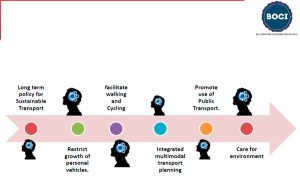A Busworld session had restoration of buses in public transport as the focal point. Deepti Thore details the action roadmap that has Asian cities partnering with the industry.
Public transport was hit massively in Asian cities with the onset of the pandemic and due to low ridership, operators are forced to think about their future viability. To support the public transport bus industry and lay a roadmap for their restoration, Busworld in association with Messe Frankfurt hosted a webinar where industry experts from Asian cities deliberated on how to fight the crisis and restore the buses in public transport. With several restrictions imposed due to the pandemic, it has become a challenge for the bus operators and manufacturers to return to normalcy. Speaking about changing preferences of people choosing individual vehicles over public transport, Jan Deman, Director, Busworld Foundation pointed that this shift will lead to an increase in traffic and air pollution for which collectivisation of public transport is very important. He stressed the need for collaboration between the private and public bus and coach sectors for the goals to be achieved.
 To boost the sector, Busworld will be representing bus and coach manufacturers and operators in the environmentally sustainable transport forum organised by the United Nations, to be held in Japan from October 18-28, 2021. “During this conference, a declaration will be signed by over 30 Southeast Asian countries on the future of their transport system,” Deman announced. The purpose of the conference is to ensure that the decision makers of public transport systems are aware of the solutions that the industry has to offer, he added. Witnessing lack of participation from the private sector in the previously held conferences, Jan pointed that it is crucial that the public authorities create incentives to make the conferences attractive for the private sector to participate, especially in Southeast Asian countries having the strongest growth in population.
To boost the sector, Busworld will be representing bus and coach manufacturers and operators in the environmentally sustainable transport forum organised by the United Nations, to be held in Japan from October 18-28, 2021. “During this conference, a declaration will be signed by over 30 Southeast Asian countries on the future of their transport system,” Deman announced. The purpose of the conference is to ensure that the decision makers of public transport systems are aware of the solutions that the industry has to offer, he added. Witnessing lack of participation from the private sector in the previously held conferences, Jan pointed that it is crucial that the public authorities create incentives to make the conferences attractive for the private sector to participate, especially in Southeast Asian countries having the strongest growth in population.
Buses for sustainable transport
In India, for example, close to 90 per cent bus transport is managed by the private sector and therefore, it is important to ensure the sustainability of public transport, highlighted Dr. Kulwant Singh, Advisor, Busworld Academy. Universal accessibility is central to achieving the Sustainable Development Goals (SDGs). “Bus as a public transport ensures such accessibility and regional connectivity in a much cheaper, faster and cost effective way,” highlighted CRC Mohanty, Environment Programme Coordinator, UNCRD. The COVID 19 pandemic had unprecedented impact, causing enormous changes to the transport landscape in the Asia pacific region. It is however considered that the transport sector can help deliver greener and more resilient infrastructure in countries around the world. Public transport, especially the buses, play an important role in densely populated cities where it provides the most efficient way of transporting large numbers of passengers in a cost effective, affordable and environmentally friendly way. However, to ensure this the government needs to work in partnership with the private sector to ensure it is enabling regulatory and the legislative environment to facilitate innovation.
According to Mohanty, there is a need for greater resilience in the public transport system and the bus system. It involves resilience against climate change, natural disasters, climate induced natural disasters, unexpected economic shocks or health emergencies like Covid-19 pandemic. To build a sustainable transport system, it needs to be safe, accessible, affordable and efficient. Modern technologies, including big data, artificial intelligence, digitalisation, automation combined with behavioral change that prioritise most sustainable transport options are considered as innovative solutions to the development of the transport sector. “Enhanced approach in such areas actually can help to realize the transport development goals and to realise the sustainable goals as per the paris agreement,” pointed Mohanty. The acceptance of electric and hybrid vehicles is crucial as it will offer tremendous environmental benefits as compared to the diesel buses. By 2030 it is expected that Asia will have 51 per cent of the global population, 41 per cent of the GDP in purchasing power parity, 34 per cent of the global transport CO2 emissions, and 58 per cent of the worldwide road traffic accident, and the success of various global agreements such as SDGs, the Paris agreement on climate change among others at regional or sectoral level will largely depend on transformational changes in the transport sector. This will include the enabling changes in policy, institutional framework, financing model, data management approaches, application of various technologies to bring such changes.
Challenges for the ecosystem
There are two key challenges which the bus industry might face when it comes to restoration, cited Mohanty. Firstly, how to tackle the capacity challenges on public transport in context of safe distancing requirements and how best to regain public confidence to encourage a return of buses in public transport. Few other challenges that the sector faces are increasing fuel prices. The need is to retain prices for atleast a period of six months, opined Prasanna Patwardhan, President, Bus and Car Operators Confederation of India (BOCI). While a lot of importance is given to electrification of vehicles, there are no banks who in ready to finance in buses due to which the bus transport system are facing a lot of issues. Private bus segment grew by 300 per cent and STUs degrew. Speaking about the situation in Jakarta, Basri Fahriza, Head of Bachelor Program, Trisakti Institute of Transport and Logistics Trisakti, Jakarta, Indonesia gave an example of Transjakarta, a BRT in Jakarta, Indonesia which is supported by several bus operators to manage fleets and serve each corridor. Transportation in Jakarta is affordable hence people prefer to travel by bus which has helped reduce the traffic congestion in Jakarta.
Prioritising investment
Voicing the troubles faced by the public transport system in India, Patwardhan highlighted the need for prioritising investments. The investments in the metro are much on the higher side as compared to the city buses. He drew attention to the investment of multi billion dollars in Delhi Metro Rail Station carrying 50 lakh passengers daily and Delhi buses finding a very low investment carrying similar number of passengers. Similarly, the investment in the airport of Bhopal carrying 1200 passengers per day is much higher than the bus stations at Bhopal carrying one lakh passengers daily. Also the land provided is much lesser than that provided to the airport authorities. He stressed on the need to increase investments in public transports. The need is to invest in bus or multimodal terminals and parking lots for private or public transport services. Increasing investments in highway project won’t alone fight the problem of congestion; the need is to facilitate movement of people over movement of vehicle, he opined. According to Patwardhan, in the last 60 years, the road sector has witnessed rise in passenger traffic from 30 to 90 per cent when compared to rail and therefore, it is high time for the government to give buses the required support to curb the congestion. According to Ganesh Raj Joshi, Researcher, UNCRD, by 2050 private car ownership will increase by 500 per cent thus leading to more congestion. To compete with 88 by private vehicles, the need is to offer the desired comfort in the buses. The lack of technology in public buses is the reason for passengers choosing private vehicles over buses and to overcome this buses should be equipped with smart or intelligent devices and other technological advancements. This will ensure improvement in efficiency.
For the revival of public transport, public-private partnership is crucial to provide the desired infrastructure, trained, experienced managing staff, established systems and procedures, support for adapting to new technology, and responsiveness to passenger demand. Flexibility, fast decision making and cost effectiveness in operations, will also play a key role. Providing an end to end better experience like Metro to bus users will also be helpful. Unless there is no door to door services public transport will not increase. Sufficient funding should be provided to keep public transport services affordable for all. Establishing planning and monitoring authority at central, state and local level is also essential. The need is to also develop integrated modern and attractive public transport systems. Redbus, the online bus ticket booking platform, is channelising demands to help the bus industry in demand forecasting, demand heatmaps and GPS. It is also enabling seamless online bookings. The need is for rapid adoption of technology on the supply and demand side, mentioned Manoj Agarwala, Sr. Vice President, redBus. Working with cities to promote green technologies is also crucial. It is only through the collaboration of Asian cities with the transport bodies, the restoration of buses in public transport could be achieved.
…………………………………………………………..
The upcoming edition of Busworld Southeast Asia 2022 will be held in Jakarta, in March. It will be followed by Busworld India from August 2022, in Bengaluru.
Also read, Resuming bus manufacturing and operations during and after lockdown





























